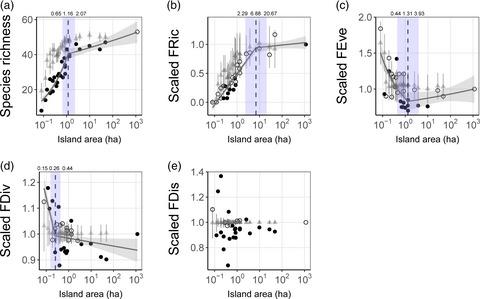Our official English website, www.x-mol.net, welcomes your
feedback! (Note: you will need to create a separate account there.)
Nonlinear thresholds in the effects of island area on functional diversity in woody plant communities
Journal of Ecology ( IF 5.3 ) Pub Date : 2021-02-24 , DOI: 10.1111/1365-2745.13632 Aiying Zhang 1 , Shilu Zheng 2, 3 , Raphael K. Didham 2, 3 , Robert D. Holt 4 , Mingjian Yu 1
中文翻译:

岛屿面积对木本植物群落功能多样性影响的非线性阈值
更新日期:2021-02-24
Journal of Ecology ( IF 5.3 ) Pub Date : 2021-02-24 , DOI: 10.1111/1365-2745.13632 Aiying Zhang 1 , Shilu Zheng 2, 3 , Raphael K. Didham 2, 3 , Robert D. Holt 4 , Mingjian Yu 1
Affiliation

|
- Threshold nonlinearities in the relationship between island area and species richness can result in dramatic declines in richness with a seemingly small decline in area near the threshold. What is not known, is whether threshold declines in richness are also accompanied by nonlinear changes in functional trait space and non‐random shifts of trait group composition in response to declining area.
- Plant species richness was recorded, and four functional diversity (FD) indices calculated based on 12 traits for 76 tree species in 5,082 plots (5 × 5 m) on 29 islands in the Thousand Island Lake region, Zhejiang, China. We tested for threshold nonlinearities in richness and FD relationships using segmented regression, with randomized resampling using a null model to account for potential sampling artefacts. We clustered tree species into trait groupings based on trait dissimilarity, and used multinomial segmented models to test whether threshold area effects on FD were associated with shifts in trait group composition.
- Species richness and three of the four FD indices showed significant threshold nonlinearities with declining island area below a threshold of ca 1.16–6.88 ha. K‐means clustering identified two trait groups, reflecting species at the ‘fast’ versus ’slow’ ends of the trait spectrum. Significant area thresholds in trait group composition were driven by increasing relative richness, but decreasing relative abundance, of species with resource‐conservation traits on islands below the threshold.
- Synthesis. We found a threshold collapse in richness on islands below c. 1 ha, resulting in a significant decrease in functional trait space (functional richness) and an increase in the degree of niche differentiation among species in the community (functional divergence) on small islands. Threshold effects were associated with non‐random re‐assembly of trait group composition, favouring the relative richness of species at the ‘slow’ resource‐conservation end of the trait spectrum, but the relative abundance of a few species with ‘fast’ resource‐acquisition traits. These results suggest that disturbance‐driven dynamics potentially drive a functional shift in the ecosystem state at a critical threshold. We show that a minimum critical habitat area is required to maintain functional diversity in woody plant communities.
中文翻译:

岛屿面积对木本植物群落功能多样性影响的非线性阈值
- 岛屿面积与物种丰富度之间关系中的阈值非线性可能导致丰富度急剧下降,而接近阈值的面积似乎很小。尚不清楚的是,丰富度的阈值下降是否还伴随着功能性状空间的非线性变化以及响应于面积减少的性状组组成的非随机变化。
- 记录植物物种丰富度,并基于浙江千岛湖地区29个岛上5,082个样地(5×5 m)中76种树种的12个性状计算出四个功能多样性指数。我们使用分段回归测试了富度和FD关系中的阈值非线性,并使用空模型进行了随机重采样以说明潜在的采样伪像。我们基于特质差异将树种聚类为特质分组,并使用多项式分段模型来检验阈值区域对FD的影响是否与特质组组成的变化相关。
- 物种丰富度和四个FD指数中的三个显示出显着的阈值非线性,其中岛屿面积下降到大约1.16–6.88 ha的阈值以下。K均值聚类确定了两个性状群,反映了性状谱的“快”端与“慢”端的物种。在岛上具有资源保护性状的物种,其相对丰富度增加,但相对丰度却降低,从而导致特征组组成的重要区域阈值。
- 综合。我们发现低于c的岛屿的富裕度阈值崩溃。1公顷,导致小岛上的功能性状特征空间(功能丰富性)显着减少,群落中物种之间的生态位分化程度增加(功能性分歧)。阈值效应与特征群组成的非随机重组有关,有利于特征谱“缓慢”的资源保存末端物种的相对丰富度,但少数物种具有“快速”资源的相对丰富度-习得特征。这些结果表明,扰动驱动的动力学有可能在临界阈值上推动生态系统状态的功能转变。我们表明,需要最低限度的关键栖息地面积来维持木本植物群落的功能多样性。











































 京公网安备 11010802027423号
京公网安备 11010802027423号